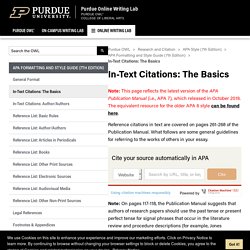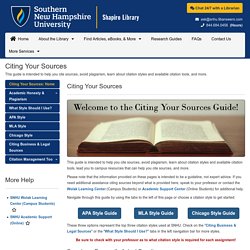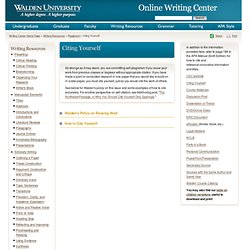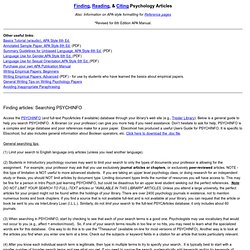

APA Formatting and Style Guide. This page is brought to you by the OWL at Purdue University.

When printing this page, you must include the entire legal notice. Copyright ©1995-2018 by The Writing Lab & The OWL at Purdue and Purdue University. All rights reserved. This material may not be published, reproduced, broadcast, rewritten, or redistributed without permission. Use of this site constitutes acceptance of our terms and conditions of fair use. Summary: APA (American Psychological Association) style is most commonly used to cite sources within the social sciences. Cite your source automatically in APA Powered by Reference citations in text are covered on pages 169-179 of the Publication Manual. Note: APA style requires authors to use the past tense or present perfect tense when using signal phrases to describe earlier research, for example, Jones (1998) found or Jones (1998) has found... APA citation basics When using APA format, follow the author-date method of in-text citation. Short quotations Long quotations.
Home - Citing Your Sources - Research Guides at Southern New Hampshire University - Shapiro Library. What exactly is plagiarism?

Let's go to a source! As defined by Merriam-Webster's Collegiate Dictionary, 11th ed. to plagiarize is: "to steal and pass off (the ideas or words of another) as one's own : use (another's production) without crediting the source : to commit literary theft : present as new and original an idea or product derived from an existing source. " What are some examples of plagiarism? Copying a sentence, whole paragraph, or large blocks of text from another source without citing it.Copying from an online source or web site, such as Wikipedia.Copying someone else's work, including your friends and classmates.Purchasing and/or downloading a paper from the Internet and turning it in as your own.Taking someone else's ideas and words and re-phrasing it in your own words, without citing the original source.Not using quotation marks properly for direct quotations.Turning in someone's else work as your own.
What do you NOT have to cite? Tips on Avoiding Plagiarism. Diagnosis: Plagiarism. The Dark Side of Plagiarism. Frequently Asked Questions. Avoiding Plagiarism. Summary: There are few intellectual offenses more serious than plagiarism in academic and professional contexts.

This resource offers advice on how to avoid plagiarism in your work. Contributors:Karl Stolley, Allen Brizee, Joshua M. PaizLast Edited: 2014-10-10 09:01:36 Research-based writing in American institutions, both educational and corporate, is filled with rules that writers, particularly beginners, aren't aware of or don't know how to follow. While some rhetorical traditions may not insist so heavily on documenting sources of words, ideas, images, sounds, etc., American academic rhetorical tradition does.
(Purdue University students will want to make sure that they are familiar with Purdue's official academic dishonesty policy as well as any additional policies that their instructors have implemented.) Intellectual challenges in American academic writing There are some intellectual challenges that all students are faced with when writing. Quoting, Paraphrasing, and Summarizing. It's Here: A new look for the Purdue OWL!

The new version of the Purdue OWL is available at Worry not! Our navigation menu and content will remain largely the same. In 11 days, we will be discontinuing owl.english.purdue.edu and you will be automatically redirected to the new site. Summary: This handout is intended to help you become more comfortable with the uses of and distinctions among quotations, paraphrases, and summaries. Contributors:Dana Lynn Driscoll, Allen BrizeeLast Edited: 2013-02-15 09:44:45 What are the differences among quoting, paraphrasing, and summarizing? These three ways of incorporating other writers' work into your own writing differ according to the closeness of your writing to the source writing.
Quotations must be identical to the original, using a narrow segment of the source. Paraphrasing involves putting a passage from source material into your own words. Plagiarism. Citing Yourself. If you cite or quote your previous work, treat yourself as the author and your own previous course work as an unpublished paper, as shown in the APA publication manual.

For example, if Marie Briggs wanted to cite a paper she wrote at Walden in 2012, her in-text citation might look like this: Briggs (2012) asserted that previous literature on the psychology of tightrope walkers was faulty in that it "presumed that risk-taking behaviors align neatly with certain personality traits or disorders" (p. 4). And in the reference list: Briggs, M. (2012).
An analysis of personality theory. Manuscript, Walden University. Why Cite? Avoiding plagiarism, self-plagiarism, and other questionable writing practices: A guide to ethical writing. Find, Read, & Cite Journal Articles. Other useful links: Basics Tutorial (w/audio), APA Style 6th Ed.

Annotated Sample Paper, APA Style 6th Ed. (PDF) Summary Guidelines for Unbiased Language, APA Style 6th Ed. (PDF) Language Use for Gender,APA Style 6th Ed. (PDF) Language Use for Sexual Orientation,APA Style 6th Ed. (PDF) Purchase your own APA Publication Manual Writing Empirical Papers: Beginners Writing Empirical Papers: Advanced (PDF) - for use by students who have learned the basics about empirical papers. Finding articles: Searching PSYCHINFO Access the PSYCHINFO (and full-text PsycArticles if available) database through your library's web site (e.g., Trexler Library) . (1) Limit your search to English language only articles (unless you read another language). (2) Students in Introductory psychology courses may want to limit your search to only the types of documents your professor is allowing for the assignment. . (6) After conducting any given search, you will get a list of article titles. Finding.
Finding. Son of Citation Machine.